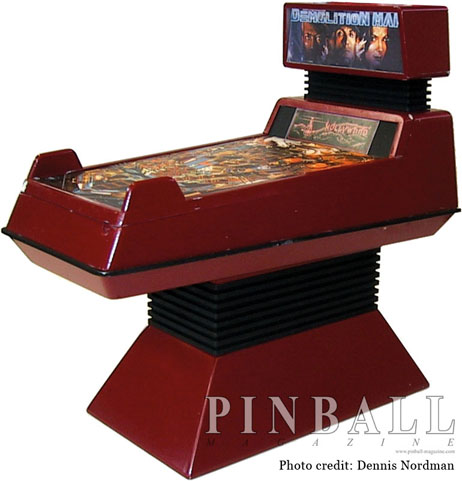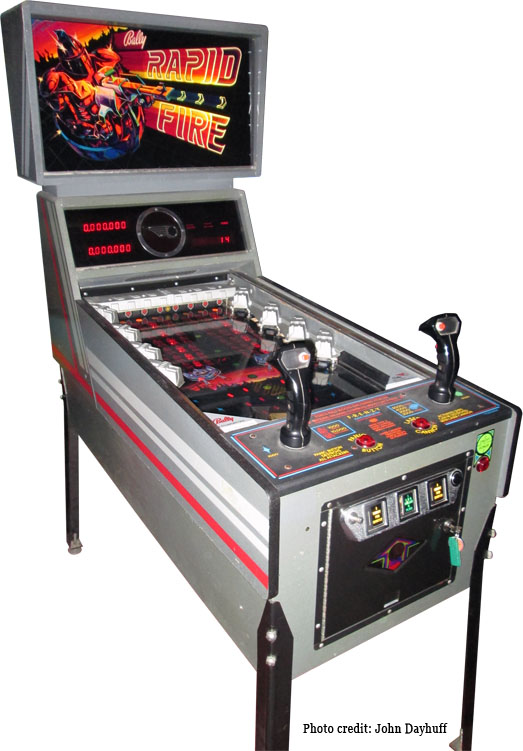This is part 2/3 of the first chapter of the Dennis Nordman interview, published in Pinball Magazine No. 2. Part 1 was published two days ago. Part 3 will be published in two days. In the first chapter of the interview Dennis about how he became a pinball designer. In the remaining seventeen chapters all of Dennis’ pinball designs are discussed by Dennis and graphic artist Greg Freres. Greg worked closely with Dennis on at least five of his designs. The entire interview covers 90 pages in Pinball Magazine No. 2, not counting contributions by people like pinball designers Steve Ritchie and John Popadiuk, graphic artists Doug Watson, John Youssi and Pat McMahon, technical right hands Mark Weyna and Ken Walker and others.
PM: Why are the Demolition Man images on there?
DN: That was the game I was working on at the time. When I built the model in college it had no art work on it so, I changed it to Demolition Man. It was not a model for Demolition Man; I just wanted to put some artwork on it, so I chose Demolition Man.
After I built the full-size version of the cabinet, I found a photographer who also studied at OSU. He came out and outside the shed he hung a big white backdrop, we set up the game there and he set up his lights all around. I had gone to the mall a few days before looking for some attractive girl who would model for me. It was really like the first girl I asked, and she said she’d love to do it. So then I used those slides to make my presentation at Bally.
Now here’s the really, really, really interesting thing about that girl; She did the modeling and I took her out to dinner and we saw each other a few times, but nothing ever developed out of that. So, I get my job at Bally and was working there for however long, and one year I went to the Pinball Expo. I’m walking around and there’s the girl. I was like “Oh my God. How did you get here? What are you doing here?” She was Rob Berk’s (one of the organizers of Pinball Expo – PM) girlfriend at the time. Rob Berk is from Warren, Ohio. I was from Columbus, Ohio and this girl was working at a mall in Columbus, but she was from Cleveland. That was a unique connection there.
PM: Did you consider other companies as well, beside Bally to show your cabinet?
DN: No, I didn’t, I had that connection with Bally. Chuck said he’d hire me so that’s who I went with. It took them a couple of weeks to make the decision; they didn’t hire me that day.
PM: But you never went back to college?
DN: No. I didn’t go back.
PM: So now you’re hired at Bally to work on cabinets, what was the first project you were assigned to? DN: When I got to Bally they put me in a little office with this kid; He was about eighteen or nineteen years old; I was about thirty-one. He was showing me all his pinball ideas and he was working on a game design. His name was John Popadiuk! That’s how I met John. John was probably the first guy I became friends with when I arrived in Chicago. Later, he got laid off along with Ward Pemberton, because things weren’t going that well for Bally at the time. I think John went back to Canada for a while and he didn’t get back into the industry until later.
PM: Tell us about some of your early cabinet designs.
DN: The first game I worked on was probably the Rapid Fire cabinet. Bally didn’t move many Rapid Fire games and they had a lot of cabinets left. So when they did Eightball Deluxe Limited Edition, they reused those cabinets, and again for Centaur II.
I also did some work on the Rapid Fire playfield design. I was still a pretty new guy when that project came into being. The VP of Bally was insisting we do something like Hyperball [Williams’ 1981 Flipperless game – PM] . They thought that game was the future of the industry, or something. I don’t think
Norm Clark was too interested in doing it. He didn’t want to do it, so, since I was the new guy, he gave it to me as a project. I thought it was a great opportunity until I realized nobody was really crazy about doing that project.
Internally it was known as Project Xerox.
I remember I built the wood molds for the vacuum- formed tanks along each side. I remember staying up all night at home working on those things. The game was later taken over by Jim Patla – somebody with experience – who could get it done. The Force Field was my idea, I think there were some thumb buttons on the handle, and you could move the Force Field back and forward and block the shots from the bad guys.
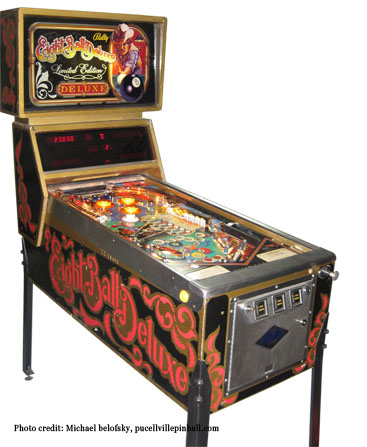
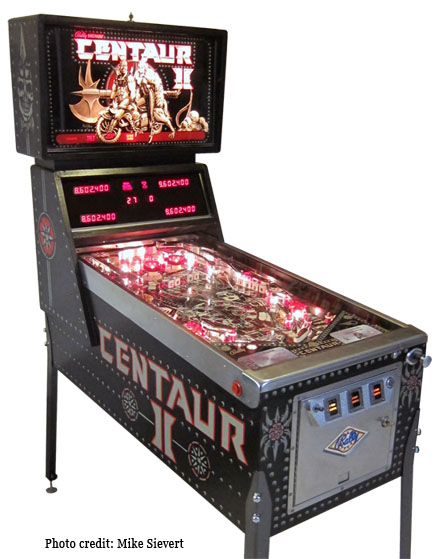
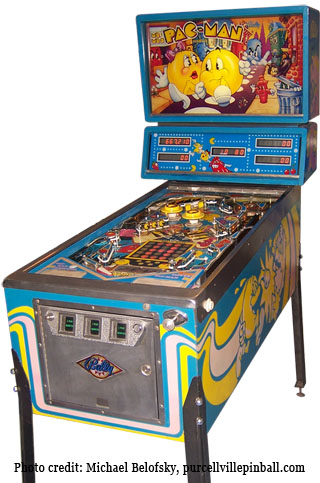 The Mr. and Mrs. Pac-Man cabinet was a whole differentbackbox; I was just trying to do some things differently. The artists didn’t like that one – actually they didn’t like the Rapid Fire cabinet either – because it made their backglasses smaller, they had less space to work with. So the artists, including Greg (Freres), Kevin O’Conner, Margaret Hudson, Pat McMahon and Paul Faris, weren’t that impressed.
The Mr. and Mrs. Pac-Man cabinet was a whole differentbackbox; I was just trying to do some things differently. The artists didn’t like that one – actually they didn’t like the Rapid Fire cabinet either – because it made their backglasses smaller, they had less space to work with. So the artists, including Greg (Freres), Kevin O’Conner, Margaret Hudson, Pat McMahon and Paul Faris, weren’t that impressed.
PM: Anything else important happen in those early days?
DN: The most important thing, as soon as I came to Bally, was when I had my talk with the president and made my presentation. I met the president’s secretary. The first time I saw her I thought, “Wow what a stunning woman that is.” When I started at Bally we talked more and more and then we started going out and a year later we got married. That’s how I met my dear wife Barbara.
She was Billy O’Donnell’s secretary, and then she was Chuck Farmer’s secretary. After we merged with Williams she was Joe Dillon’s secretary for a while. She has some great stories from the old days, but she won’t tell them to anybody. She’s a good secretary.
PM: So, what is it with pinball designers hitting on their bosses’ secretaries?
DN: Bally was a small company. There were not a lot of people there and yet I can think of four marriages that came about from the people that met while working there. Maybe playing pinball brought them together, or there’s something in the water over there. Greg Freres and his wife Andi also met at Bally. Andi and Barbara sat across from each other. Then there was Ward’s wife Joyce and Pat McMahon’s wife Debbie. So, at least four couples met there. I think Jim Patla also met his wife at Bally, but he was already married when I got there. That’s a lot of marriages.
Now as for my wife Barbara, if you knew how much stuff she used to throw away, all this promotional stuff that would be worth a fortune on eBay today; flyers, brochures, give-aways. If she needed to make room for a new game, she just took all the stuff from an old game and threw it in the trash. Pens, T-shirts, the stuff she threw away would make you cry.
PM: So she’s not that much into pinball?
DN: No, not at all. When I was at Williams and I would bring home some stuff from a game I worked on, she could tell me: “Quit bringing all that sh*t home.” [laughing]
PM: Apart from bringing the scoring displays closer to the playfield, which was the case on Rapid Fire, Centaur II, Eightball Deluxe Limited Edition and Mr. & Mrs. Pac-Man, did Bally use any of your other innovations on their games?
DN: I think the speaker in Rapid Fire was in the middle of the displays, just above the playfield. So here were two things. The other stuff never happened. They already had experience from building Kiss with a fiberglass cabinet. I remember seeing it, but it wasn’t a good experience for Bally, so they wanted to stay away from fiberglass. Besides, they wanted to put the money into the game, not the cabinet. The game wasn’t meant for home use. Operators didn’t care about cabinet design; they just wanted to know how much money the game took in. It was hard to justify spending money on the cabinet.
Tradeshows
When I first started at Bally, I went to my first tradeshow. I think Patla had Centaur there. I was so impressed being around so many pinball game designers. I thought, “What a cool job” and “Look, he created this game and everybody’s playing it and everybody loves it.” Then we went to the Bally party afterwards and I never saw a thing like that in my life. I mean there was a huge ballroom with a ten- or fifteen-piece orchestra playing music. They had ice sculptures and hors d’oeuvre bars with things like lamb chops and shrimp. Man, those were pretty exciting days. Everybody was drinking and acting crazy. It was fun! I went to three or four tradeshows like that before things went to hell. [laughing] The tradeshows were really cool. Also because you got to play the competition’s games and see what all the other companies were doing.
Orbitor 1
I remember when I saw Stern’s Orbitor 1 at one of the tradeshows I was very impressed. The thing I didn’t like was the way it curved around the flippers. I thought everything else was really cool, but you didn’t have any control by the flippers. That’s the one thing I didn’t like about it, but I loved everything else. I loved the vacuum-formed playfield with the moon scene under it and the spinners. The pop bumpers were very innovative. If they had made it so that you’d have ball control by the flippers I think it would have been a much more successful game.
PM: Then what happened?
DN: Within a year I got laid off. Bally merged with Midway and that’s when I got laid off. I was just in and already let go. The interesting thing about this is that my wife knew about the layoffs and couldn’t tell me. She was a good secretary.
Within a day or two I got a job at Gottlieb, before they changed to Mylstar. I wasn’t hired to do anything with pinball, but instead to create video game concepts.
>>> To be continued >>>
The entire Dennis Nordman & Greg Freres interview, which covers more than 100 pages, is published in Pinball Magazine No. 2. Order your copy in the Pinball Magazine web shop.

